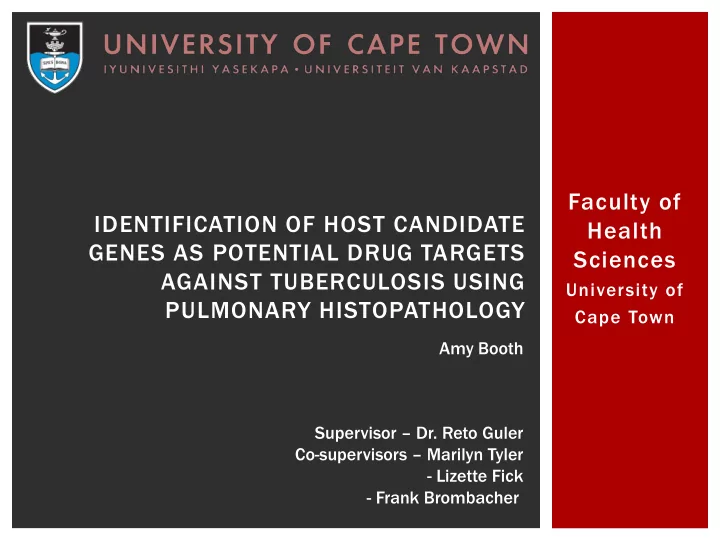

Faculty of IDENTIFICATION OF HOST CANDIDATE Health GENES AS POTENTIAL DRUG TARGETS Sciences AGAINST TUBERCULOSIS USING University of PULMONARY HISTOPATHOLOGY Cape Town Amy Booth Supervisor – Dr. Reto Guler Co-supervisors – Marilyn Tyler - Lizette Fick - Frank Brombacher
HISTORY OF TUBERCULOSIS
IDENTIFICATION OF HOST CANDIDATE GENES AS POTENTIAL DRUG TARGETS AGAINST TUBERCULOSIS USING PULMONARY HISTOPATHOLOGY
CONTENT A) Basic Leucine B) Blocking of the Zipper Transcription alternative activation Factor, ATF-like 2 of macrophages via (Batf2) the IL-4 Receptor alpha chain (IL-4R α ) IL-4R α
IMMUNE RESPONSE TO TUBERCULOSIS (1) NO
BASIC LEUCINE ZIPPER Part A TRANSCRIPTION FACTOR, ATF-LIKE 2 (BATF2)
BASIC LEUCINE ZIPPER TRANSCRIPTION FACTOR, ATF-LIKE 2 (BATF2) Protein encoding gene Suppresses Activator Protein 1 which regulates gene expression in response to cytokines and pathogens (Karin et.al, Murphy et.al.) Induction of genes involved in the early immune response and killing effector functions (Murphy et.al.): Compensates for Batf and Batf3 required for development of (Tussiwand et.al.) TH17 cells CD8+ classical dendritic cells Class-switch recombination in B cells Transcr script iption ion Factor: Protein that binds to our DNA and activates genes to bring about certain functions
BASIC LEUCINE ZIPPER TRANSCRIPTION FACTOR, ATF-LIKE 2 (BATF2) Induced by: Interferon-gamma (IFN- γ ) in classically activated macrophages Lipopolysaccharide TB infection in classically activated macrophages further enhances Batf2 expression (Roy et.al) Batf2 is an important gene in the host’s immune response to TB and absence of the Batf2 gene should theoretically increase susceptibility to TB IFN- γ LPS Batf2 Mtb
Confirm the involvement AIM of Batf2 in either a protective or detrimental immune response to TB
METHOD Mice Wildtype (Batf2+/+), Heterozygous (Batf2+/-), Knockout (Batf2-/-) Infected Intranasally with clinical strain Mtb HN878 Sacrificed after 3 and 6 weeks of infection Lungs were sectioned and stained: H&E
METHOD Lungs were examined using the Nikon NIS-elements Advanced Research Microscope for area of lesion size
METHOD Pulmonary histopathology scoring (1-10) 8 6 3 Statistical analysis: T-test Two-tailed with unequal variance
RESULTS BATF2 Batf2 +/+ (Normal) Batf2 +/- (Heterozygous) Batf2 -/- (Knockout) 3 Weeks 6 Weeks
RESULTS BATF2 Batf2 +/+ (Normal) Batf2 +/- (Heterozygous) Batf2 -/- (Knockout) 3 Weeks 6 Weeks
RESULTS BATF2
RESULTS BATF2
DISCUSSION BATF2 Batf2 deficient mice showed reduced pulmonary histopathology than wild-type mice Reasons: Reduced production of CD8+ T cells Reduced production of IFN- γ (Interferon gamma) Reduced production of Reactive Oxygen Species (ROS), Nitric Oxide (NO) and other inflammatory mediators Reduced production of TNF- α (Tumour Necrosis Factor – alpha) Reduced bacterial presentation Reduced induction of immune cells TB represents the fine balance between protection and immunopathology
BLOCKING OF Part B ALTERNATIVE ACTIVATION OF MACROPHAGES VIA IL-4R α
ACTIVATION OF MACROPHAGES
BLOCKING OF ALTERNATIVE ACTIVATION OF MACROPHAGES VIA IL-4R α Classical Activation IFN- γ TNF- α Blocki king g the e LPS Microbicidal IL4R α could ld Cell Immunity inc ncrea rease se availa ilabl ble e Tissue Damage NO arginin inine e for the e iNOS production roduction of L-arginine Nitric tric Ox Oxide ide (NO) O) Arginase L-ornithine and nd thus s redu duce ced d Wound healing susceptib ceptibil ility ity to Tissue homeostasis TB TB Granuloma Formation IL-4 IL-4R α IL-13 Alternative Activation
Determine whether blocking AIM the alternative activation of macrophages via the IL-4R-alpha would decrease susceptibility to TB by increasing the available L-arginine for the production of NO.
METHOD Mice Balb/c (Wildtype), IL-4R α -/- Infected with Mtb HN878 via intranasal and aerosol route Sacrificed after 4 and 18 weeks of infection Stain: iNOS - indicates classical activation of macrophages Arginase - indicates alternative activation of macrophages
RESULTS IL-4R α
RESULTS IL-4R α
RESULTS IL-4R α
RESULTS IL-4R α
DISCUSSION IL-4R α Induction of arginase in the absence of IL-4R α indicates an IL- 4R α -independent pathway for arginase production TB can induce production of arginase via the MyD88 pathway (Qualls et.al) IL IL-4R 4R α deficient mice showed reduced pulmonary histopathology in the late stage of TB infection Reasons: Reduced activation of wound repair and restoration of tissue homeostasis Immunopathology due to increased production of pro-inflammatory Th1 cytokines
CONCLUSION A) Batf2 is a possible drug target as Batf2 deficient mice showed reduced pulmonary histopathology B) IL IL-4R α is not a possible drug target due to TB’s ability to alternatively activate macrophages in an IL-4R α -independent manner
ACKNOWLEDGEMENTS I would like to acknowledge Dr Reto Guler, Ms Marilyn Tyler and Ms Lizette Fick for their immense assistance and support during this project. Without them, this would not have been possible.
REFERENCES 1. O'Garra A, Redford PS, McNab FW, Bloom CI, Wilkinson RJ, Berry MP. The immune response in tuberculosis. Annual review of immunology. 2013;31:475 -527. 2. Karin M, Liu Z, Zandi E. AP-1 function and regulation. Current opinion in cell biology. 1997;9(2):240-6. 3. Murphy TL, Tussiwand R, Murphy KM. Specificity through cooperation: BATF -IRF interactions control immune-regulatory networks. Nature reviews Immunology. 2013;13(7):499 -509. 4. Roy S, Guler R, Parihar S, Schmeier S, Kaczkowski B, Nishimura H. Macrophage Batf2/Irf1 regulates inflammatory responses with prolonged survival in tuberculosis in Batf2 deficient mice. Unpublished2014. 5. Classen A, Lloberas J, Celada A. Macrophage activation: classical versus alternative. Methods in molecular biology. 2009;531:29 -43. 6. Gordon S, Martinez FO. Alternative activation of macrophages: mechanism and functions. Immunity. 2010;32(5):593-604. 7. Qualls J, Neale G, Amber S, Koo M -S, Ashley D, Huiyan Z, et al. Arginine usage in Mycobacteria - infected macrophages depends on autocrine -paracrine cytokine signalling. Cell Signalling Technology. 2010;3(135).
IMAGE REFERENCES Slide 3: www.nature.com Slide 4: http://immunopaedia.org.za/index.php?id=250 Slide 6: www.nature.com Slide 18: Gordon S, Martinez FO. Alternative activation of macrophages: mechanism and functions. Nature Reviews Immunology. 2003;3: 26. Slide 19: Gordon S, Martinez FO. Alternative activation of macrophages: mechanism and functions. Nature Reviews Immunology. 2003;3: 32.
Recommend
More recommend